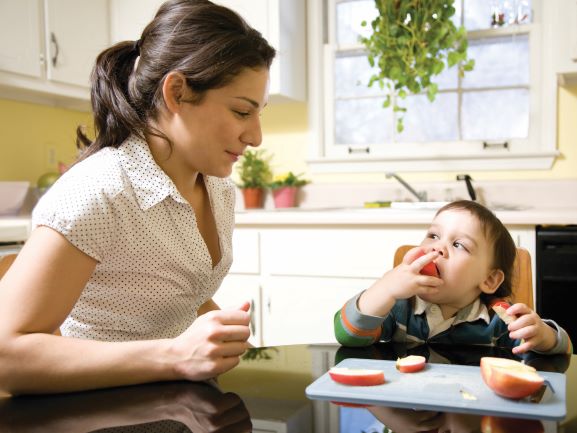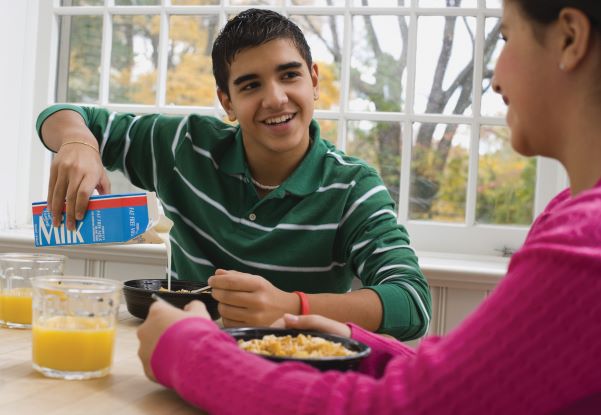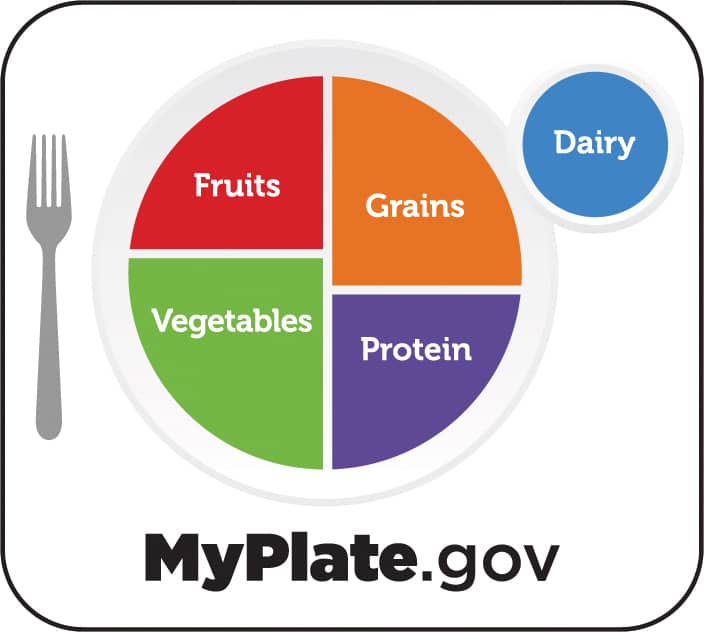Helping Your Child: Tips for Parents & Other Caregivers
In this section:
Parents and other caregivers can guide children to develop lifestyle habits that will support their good health for years to come. We know that as a parent or caregiver you may not have all the answers. Like many Americans, you may even struggle to develop and stick with healthy habits of your own. One way to win this double struggle is to practice healthy lifestyle habits—together!
Consuming healthful foods and beverages, doing regular physical activity, getting adequate sleep, and other factors may help children to
- grow
- learn
- build strong bones and muscles
- maintain a healthy weight
- reduce future chances of developing diabetes and heart disease
- feel good about themselves

Healthy Habits
How can I help my child form healthy habits?
As a parent or caregiver, you play a big part in shaping children's eating and drinking habits. When you make it a habit to consume foods and beverages that are low in added sugars, saturated fat, and salt and are high in fiber, the children you care for may learn to like these foods as well. If a child you are caring for does not like a new food right away, don't be upset. Children often need to see a new food many times before they will try it.
Be a role model. As a parent or caregiver, you also have an effect on children's physical activity. You do not need to be an expert at any activity. Just get up, move, and show children how much fun being active can be. They may grow to like it too. You can set a good example by going for a walk or riding a bike instead of watching TV, playing a video game, or surfing the internet. Find an activity that you enjoy and can do together.
Talk about being healthy. As you learn more about how to improve your health, take the time to talk to your children about how a certain food or physical activity may help them. For example, when going for a walk, bring your children with you and let them pick the route. Discuss how walking helps you feel better and is a fun way to spend time together.
Use your children's food and beverage choices as teaching moments. Speak up when you see unhealthy choices. Direct children to healthier options or say, "You can have a little of that, but not too much." Talk to them about why an overly salty or heavily sugared snack is not the best choice. Avoid making them feel guilty about their food or beverage choices. You can also praise your children when they choose a healthy item like fruit.
Use comments like these
- "Great choice!"
- "You're giving your body what it needs with that snack!"
- "I like those, too."

With physical activity, try upbeat phrases like these to keep your child excited
- "You run so fast, I can hardly keep up!"
- "You are building a strong, healthy heart!"
- "Let's walk 10 more minutes to make us stronger."
Make sure your child gets enough sleep. Getting enough sleep can improve your child’s mental, emotional, and physical health. Not getting enough sleep may lead to many health issues, including obesity. Find out how many sleep hours experts recommend for your child, depending on his or her age.
Believe in the power to change. Know that eating healthy and moving more are the building blocks to better health. Work together to form healthy habits.
Promote good health beyond your family. Other adults may play a role in your child's life, too. You can share ideas about healthy habits with them. For instance, many parents and caregivers work outside the home and need others to help with childcare. Family members, day care providers, babysitters, or friends may shape your child's health habits. Talk to them to make sure they offer healthy meals, snacks, and drinks. Check that caregivers are also providing plenty of active playtime and limiting inactive time spent with TV, video games, or other devices.
If your child is in school, you can help promote healthy habits in several other ways
- Find out more about the school's breakfast and lunch programs.
- Find out about the school’s physical education program, and look for opportunities to be active during the school day.

Consider other influences. Just as they do for you, your children's friends and the media can also affect healthy choices.
Some TV, online, and other ads try to persuade children to consume high-fat foods and sugary drinks. You can help your children be aware of these pressures. Speak with your children about choices while you watch TV, surf the internet, or go to the movies with them. Talk about how media outlets and influencers sell products or convey values through famous athletes, child celebrities, cartoon and action figures, and made-up images. Use programs and ads to spark chats about your values. These talks may help your child make healthy choices outside the home.
Healthy Eating
What should my child eat and drink?
Just like adults, children need to consume foods and beverages that are packed with nutrients. Also, like adults, children should consume just enough calories to fuel their daily living and activities. The Dietary Guidelines for Americans, 2020–2025 suggest balancing calories you consume with physical activity. The guidelines also recommend improving eating habits to promote health, reduce the risk of disease, and reduce overweight and obesity. Americans ages 2 years and older are encouraged to consume a variety of healthy foods and beverages. Suggested items include
- fruits, vegetables, unsalted nuts and seeds (please make sure your child can tolerate these foods and isn’t allergic to them), and whole grains
- fat-free or low-fat dairy products, including milk, yogurt, cheese, and/or fortified nondairy beverages
- a variety of protein foods, including seafood, lean meats and poultry, eggs, legumes (beans and peas), nuts, seeds, and soy products
What foods and beverages should be limited?
Youth and adults are also encouraged to get less
- refined grains
- added sugars
- saturated fats, such as lard, butter, and margarine, which are often solid at room temperature
- salt (sodium)
Added sugars, solid fats, and salt often occur in pizzas, chips, crackers, sodas, sugar-sweetened drinks, desserts like cookies or cake, and fast foods. If children and teens consume these foods and beverages, these items should be limited on a healthy eating plan.
Another step is to make sure your children have breakfast to spark the energy they need to focus in school. Some studies suggest that eating breakfast regularly may decrease children’s chances of developing obesity.1

How can I help my child eat better?
Use less fat, salt, and sugar. Here are some ideas to help you and your child follow a healthy eating plan
- Cook with fewer solid fats. Use olive or canola oil instead of butter or margarine. Bake or roast foods instead of frying. You can get a crunchy texture with "oven-frying" recipes that involve little or no oil.
- Choose and prepare foods with less salt. Keep the salt shaker off the table. Have cut-up fruits and vegetables on hand for snacks instead of salty snacks like chips or crackers.
- Limit the amount of sugar your child eats. Choose hot or cold cereals with no added sugar or low sugar.
- Fill half of your child's plate with fruits and vegetables.
- Learn about age-appropriate portion sizes and how to avoid oversized portions.

Serve nutrient-rich foods and beverages. Many foods and beverages are particularly rich in key nutrients and vitamins—such as potassium, calcium, vitamin D, and dietary fiber—that are important to your children’s health and development. Here are some ideas for boosting your children's intake of these nutrients
- Offer more fruit for breakfast, snacks, and desserts. Add dark green, red, and orange vegetables to stews and soups. Add beans (black, kidney, pinto), peas, and lentils to casseroles and salads. For meal planning ideas and healthy recipes, see Nutrition.gov.
- Serve more low-fat milk and milk products. If your child cannot digest much lactose, called lactose intolerance, serve lactose-free milk, cheese, or yogurt. (Lactose is the sugar in milk that may cause some people stomach pain and bloating when they drink milk or eat milk products.) Your child can also try nondairy drinks, such as soy, almond, or rice drinks enriched with calcium or vitamin D.
- Serve fresh, frozen, or canned salmon, shrimp, and light tuna (not albacore). For young children, you may serve safe types of seafood (PDF, 378.44 KB) 1–2 times a week in child-sized portions, starting with 1-ounce portions at age 2.2
- Replace the refined grains (breads, pasta, rice) your child eats with whole grains. Eat more bran. Check Nutrition Facts labels to find products high in dietary fiber. Look at the ingredients list to be sure that whole grains are one of the first items.

Think about the drink.
- Serve more water.
- Offer low-fat or fat-free milk instead of whole milk.
- Avoid serving sugar-sweetened beverages and fruit-flavored drinks.
- Offer fresh fruit, which has more fiber than juice. If serving juice, offer small portions of 100% fruit juice.
Offer healthy snacks. Along with their meals, snacks can help children get enough nutrients to help them stay healthy. Buy or prepare single-serving snacks for younger children to help them get just enough to satisfy their hunger. Visit the children's section of ChooseMyPlate to help you and your kids select a satisfying snack.
Try to keep healthy food in the house for snacks and meals for the whole family. Offer such snacks as
- sliced apples, oranges, pears, and carrots
- whole-grain bread served with low-fat cheese, favorite spread, or roasted veggies
- fresh, frozen, or canned vegetables
Keep two more things in mind when choosing healthy snacks.
- Read Nutrition Facts labels to choose the appropriate serving size. Remember that the serving size on nutrition labels applies to adults’ dietary needs and is based on a 2,000-calorie diet. So, the right serving size for most children will probably be smaller than what is on the package, depending on the child’s age, size, and activity level. Visit the parents’ section of Nutrition Facts Label: Read the Label Youth Outreach Materials to find tools for helping your children make healthful food choices and understand how to read the Nutrition Facts label on food packages.
- Children of preschool age and younger can easily choke on foods. Be careful with foods that may be hard to chew, small and round, or sticky. Examples are hard vegetables, whole grapes, hard chunks of cheese, raisins, nuts and seeds, and popcorn. Select snacks with care for children in this age group.
Share food time together. The key word is “together.”
- Plan to have sit-down meals with your children; and serve everyone the same thing.
- Involve your children in planning and preparing meals. Children may be more willing to eat the dishes they help prepare.
- Try to limit how much food or beverages your child consumes on the go and away from home. That will help you control the calories, sugar, and fat your children consume. To serve more homemade meals, cook large batches of soup, stew, or casseroles and freeze them as a time saver. For handy tips on quick and easy homemade meals, visit ChooseMyPlate.gov.
- Limit eating at home to specific areas such as the kitchen or dining room—not in front of a TV or while using another electronic screen.

Physical Activity
How does physical activity help my child?
Experts (PDF, 13.8 MB) suggest that preschool-age children (ages 3 through 5 years) should be physically active throughout the day to help them grow and develop. As a parent or caregiver, you play a big role in helping kids get up and get moving.
If you are caring for preschoolers, try to make sure they get about 3 hours of physical activities each day. Those activities could be light, moderate, or vigorous in intensity. If you are caring for school-age children (ages 6 through 17 years), try to get them to do at least 1 hour of physical activity each day. Experts suggest activities that are moderately or vigorously intense. Bicycling, jumping rope, and playing basketball or soccer are some ways for children to be active.

How can I help my child be more active?
There are many ways you can help.
- As you work to develop a physical activity routine, you can be a role model for your children. If they see you being physically active and having fun, they might grow to like it and stick with it.
- Involve the whole family in activities like dancing or playing a favorite sport.
- Focus on fun. You can do a lot of walking during trips to the zoo or park.
- Include children in family activities like walking the dog, washing the car, or cleaning the house.
- Sign up your children for after-school programs or lessons in an activity or sport they enjoy, if they’re available and you can afford it.
- Team up with your children to play sports or dance video games that get everyone moving.
- Share tips with your children about how to be physically active throughout the day.
- Consider using an interactive online tool to find ways to help your children get more physical activity.

Reduce inactive screen time. Sitting for hours at a time, while using computers, hand-held devices, music players, or TVs, may reduce your child's active playtime.
Pediatricians suggest limiting the time children use digital media outside of homework time. Between ages 2 and 5, allow your children no more than 1 hour of screen time. For children ages 6 and older, set consistent limits on media time. That will help you be sure they have enough time for physical activity, play, sleep, and other healthy behaviors.3,4
Try these tips to reduce your child's screen time
- Do not use screen time to reward your child.
- Set up a family game night and turn off all the screens in your home.
- Eat meals together with no media use. Do not eat in front of a screen.
- Limit time in front of TV or other devices and remove them from your child's bedroom.
- Designate media-free places in your home, such as bedrooms.3,4
What should I do if my child is overweight or has obesity?
Children who are overweight are more likely to become adults who are overweight. These children may develop high blood pressure, type 2 diabetes, and other serious health problems. Weight problems may also lead to stress, sadness, and low self-esteem in children. Because children grow at different rates at different times, it is not always easy to tell if a child is overweight. For example, it is normal for boys to have a growth spurt in weight and catch up in height later.
Ask your health care professional to measure your children and tell you if they are in a healthy range. You can also calculate your child's body mass index (BMI), then discuss any concerns with your child's health care professional. BMI is a measure of body fat calculated from weight and height. If your provider tells you that your child weighs more than he or she should, there are ways you can help your child who is struggling with his or her weight.
How can I help my child with his or her weight?
Here are some do’s and don’ts.
- Accept and love your child at any weight. Doing so will boost self-esteem.
- Involve the whole family in following healthy habits, even if other family members are not overweight.
- Focus on healthy eating, regular physical activity, and adequate sleep, rather than a number on the scale.
- Help your child find ways other than food or beverages to handle setbacks or mark successes.
- Talk with your health care professional to get trusted advice about addressing your child’s health habits and weight. The internet is full of misinformation that may be hard to distinguish from good advice.
Remember, you play the biggest role in your children's lives. You can help your children learn healthy eating, physical activity, and other habits to follow for the rest of their lives.

References
This content is provided as a service of the National Institute of Diabetes and Digestive and Kidney Diseases
(NIDDK), part of the National Institutes of Health. NIDDK translates and disseminates research findings to increase knowledge and understanding about health and disease among patients, health professionals, and the public. Content produced by NIDDK is carefully reviewed by NIDDK scientists and other experts.
The NIDDK would like to thank:
Claudia Fox, M.D., M.P.H., University of Minnesota, Department of Pediatrics
